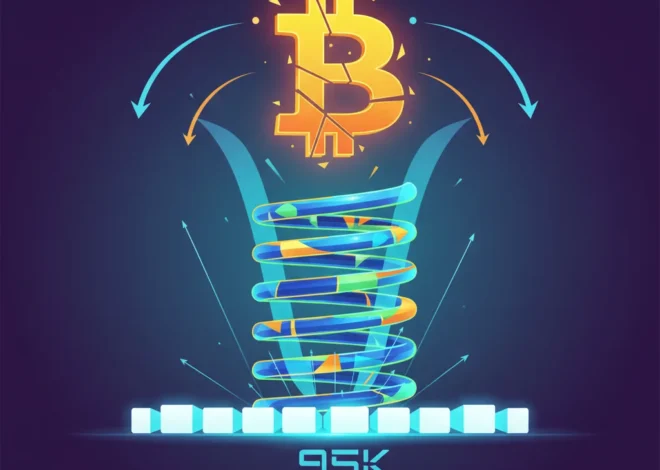
Ethereum’s Technical Blueprint: Decoding the Path to a Potential $6,000 Valuation
In the volatile world of digital assets, where market sentiment can shift as quickly as a flash of lightning, investors are constantly searching for a map to navigate the uncertainty. Following a recent, sharp “flash crash,” the cryptocurrency market has been a hotbed of speculation. For Ethereum (ETH), the second-largest digital asset and the backbone of decentralized finance (DeFi), this period of turbulence may have set the stage for a remarkable recovery and a significant upward trajectory. A detailed technical analysis suggests that, far from being a bearish omen, the recent low could be the launching pad for a rally that targets price levels above $6,000.
This post will unpack the technical indicators behind this bold prediction, translating complex charting concepts into a clear, actionable framework for investors, finance professionals, and business leaders. We will explore the key patterns forming on Ethereum’s price chart, the mathematical principles guiding future targets, and the critical levels that could either validate or invalidate this bullish thesis. Understanding this technical roadmap is crucial for anyone involved in the modern financial landscape, where the intersection of financial technology, blockchain, and traditional investing is redefining the future of the economy.
The Catalyst: Understanding the “Flash Crash” Low
Before mapping out the future, we must first understand the starting point. The analysis hinges on the low point established during a recent “flash crash”—a term used to describe an extremely rapid decline in the price of an asset, followed by an equally swift recovery. These events, while unnerving, are significant markers for technical analysts. They wash out excessive leverage from the market and establish a firm psychological and structural bottom from which new trends can emerge.
This specific low point, as identified in the source analysis, serves as the foundational anchor for the entire bullish structure. It represents a point of maximum fear that was aggressively bought up, signaling the presence of strong demand and institutional interest. For those engaged in active trading, recognizing these pivotal moments is key to distinguishing a temporary panic from a long-term trend reversal.
The Coiled Spring: Ethereum’s Symmetrical Triangle
Following the flash crash, Ethereum’s price action didn’t immediately soar. Instead, it entered a period of consolidation, meticulously crafting a pattern known to chartists as a “symmetrical triangle.” This pattern is characterized by a series of lower highs and higher lows, with trend lines converging towards a single point (the apex). Visually, it looks like a coiled spring.
What does this mean in practice? A symmetrical triangle represents a state of equilibrium and indecision in the market. Neither the buyers (bulls) nor the sellers (bears) are in full control. Volume typically diminishes as the pattern progresses, indicating that energy is being stored. This period of balance, however, is almost always resolved by a powerful breakout in one direction. Given the broader uptrend in the stock market and a general “risk-on” sentiment, analysts are betting on an upward resolution.
The key to this pattern lies in its boundaries:
- The Upper Trendline (Resistance): A decisive and sustained move above this line would confirm the bullish breakout, signaling that buyers have overwhelmed sellers and are ready to push the price higher.
- The Lower Trendline (Support): A break below this line would invalidate the bullish thesis, suggesting sellers have taken control and a deeper correction is likely.
For investors, this pattern provides clear “if-then” scenarios. The breakout is the trigger for the bullish case, while the breakdown is the signal for caution and risk management.
Mapping the Ascent: The Power of Fibonacci Extensions
Once a breakout from the symmetrical triangle is confirmed, the next logical question is: “How high could it go?” This is where a centuries-old mathematical principle, the Fibonacci sequence, comes into play. In finance, traders use Fibonacci extension levels to project potential price targets after a significant price move.
These levels are derived from the “golden ratio” (1.618) and are considered natural zones of psychological and structural importance where a price trend may pause or reverse. The analysis of Ethereum’s chart points to several key Fibonacci extension levels, calculated from the swing low of the flash crash to the subsequent high. According to the technical model, these projections create a clear roadmap for the potential bull run.
The table below outlines the primary price targets derived from this Fibonacci analysis, assuming a confirmed breakout from the triangle pattern.
| Fibonacci Extension Level | Projected Price Target (USD) | Significance and Context |
|---|---|---|
| 1.618 Extension | ~$4,870 | This is often the first major target after a strong breakout. It aligns with Ethereum’s previous all-time high, making it a critical psychological and technical resistance level. Overcoming this hurdle would be a major bullish confirmation. |
| 2.618 Extension | ~$6,370 | A more ambitious but common target in powerful bull markets. Reaching this level would signify strong momentum and widespread adoption, pushing Ethereum deep into price discovery mode (source). |
| 3.618 Extension | ~$8,000+ | In a scenario of extreme bullishness, potentially fueled by major economic shifts or landmark regulatory news (like an ETF approval), this higher extension level becomes a possibility. It represents a “blue sky” scenario. |
This structured approach transforms trading from a guessing game into a strategic exercise based on probabilities and predefined levels. Each target represents a potential area to take profits or reassess the strength of the trend.
Broader Implications for Fintech, Banking, and the Economy
An Ethereum rally to over $6,000 would have ripple effects far beyond the portfolios of crypto investors. It would serve as a powerful validation of the entire decentralized finance (DeFi) and smart contract ecosystem built upon its blockchain.
For the fintech and financial technology sectors, a thriving Ethereum network means more innovation, more development, and more user adoption of decentralized applications (dApps). This can accelerate the disruption of traditional banking services, from lending and borrowing to asset management and international payments. A higher ETH price also strengthens the network’s security, making it a more attractive platform for high-value enterprise applications.
From a macroeconomic perspective, a strong bull run in a major asset like Ethereum can be an indicator of investor appetite for risk and innovation. It often correlates with bullish sentiment in other growth-oriented sectors of the stock market. As institutional investors increasingly allocate capital to digital assets, the line between the crypto economy and the traditional economy continues to blur, making these trends relevant for all forward-thinking business leaders and finance professionals.
Conclusion: A Roadmap, Not a Guarantee
The technical analysis of Ethereum’s price chart presents a compelling and logically structured case for a potential ascent to $6,000 and beyond. The combination of a powerful reversal from a flash crash low, the consolidation within a classic symmetrical triangle, and the clear price targets offered by Fibonacci extensions provides investors with a tangible roadmap to watch.
However, it is imperative to approach this analysis with a professional mindset. This roadmap is a guide to probabilities, not a guarantee of future performance. The bullish scenario is entirely dependent on a confirmed breakout above the triangle’s resistance. Conversely, a break below its support would invalidate the immediate upside potential and signal a need for reassessment.
For those navigating the complex world of modern investing, the key takeaway is to integrate this technical perspective with a robust understanding of the fundamental drivers and the broader economic environment. By watching the key levels and understanding the story the chart is telling, investors can position themselves to make more informed, strategic decisions in one of the most exciting and transformative asset classes of our time.


